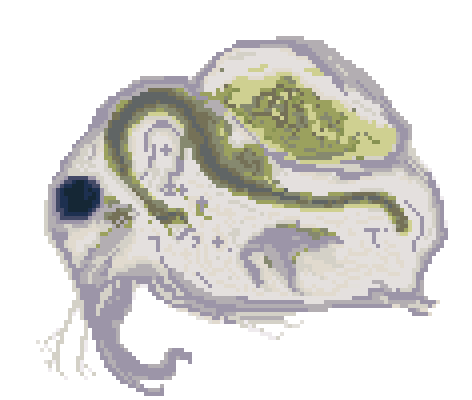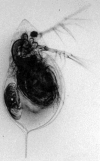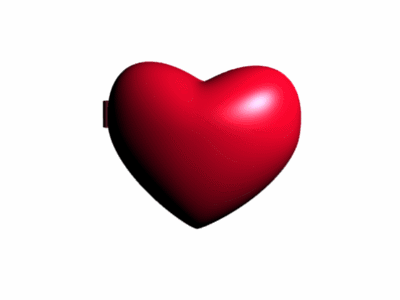
( ´ ∀ `)ノ~ ♡
♡(ミ ᵕ̣̣̣̣̣̣ ﻌ ᵕ̣̣̣̣̣̣ ミ)ノ
> daphnia are planktonic crustaceans that belong to the Phyllopoda (sometimes called Branchiopoda), which are characterized by flattened leaf-like legs used to produce a water current for the filtering apparatus. Within the branchiopods, Daphnia belong to the Cladocera, whose bodies are enclosed by an uncalcified shell (Figures 2.1 and 2.2), known as the carapace. It has a double wall, between which hemolymph flows and which is part of the body cavity. The carapace is largely made of chitin, a polysaccharide. Cladocera have up to 10 pairs of appendages, which are (from front to back): antennules, antennae (the second antennae, used for swimming); maxillae; and mandibles; followed by 5 (as in Daphnia) or 6 limbs on the trunk. The limbs form an apparatus for feeding and respiration. At the end of the abdomen is a pair of claws. The body length of Cladocera ranges from less than 0.5 mm to more than 6 mm. Males are distinguished from females by their smaller size, larger antennules, modified post-abdomen, and first legs, which are armed with a hook used in clasping. (´• ω •`) ♡
The genus Daphnia includes more than 100 known species of freshwater plankton organisms found around the world (see Figures 2.3, 2.4, and 2.5 for three European representatives of the genus). They inhabit most types of standing freshwater except for extreme habitats, such as hot springs. All age classes are good swimmers and are mostly pelagic, i.e., found in the open water. They live as filter feeders, but some species may frequently be seen clinging to substrates such as water plants or even browsing over the bottom sediments of shallow ponds. Adults range from less than 1 mm to 5 mm in size, with the smaller species typically found in ponds or lakes with fish predation. The ecology of the genus Daphnia may be better known than the ecology of any other group of organisms. (・_・ヾ
(=^-ω-^=)
Daphnia feed on small, suspended particles in the water. They are suspension feeders (filter feeders). The food is gathered with the help of a filtering apparatus, consisting of the phylopods, which are flattened leaf-like legs that produce a water current. As the current flows anterior to posterior, the Daphnia collect particles that are transferred into the food groove by special setae. Although the feeding apparatus is so efficient that even bacteria can be collected, the food is usually made up of planktonic algae. Green algae are among the best food, and most laboratory experiments are done with either Scenedesmus or Chlamydomonas, both of which are easy to culture in monoclonal chemostats. Daphnia usually consume particles from around 1 μm up to 50 μm, although particles of up to 70 μm in diameter may be found in the gut content of large individuals.
The dynamics of food uptake follow a functional response type 1. Below a certain food concentration (the incipient limiting level), the food uptake from the water (feeding rate) is proportional to the food concentration, and the filtering rate (amount of water filtered per unit time) is maximal. Above this level, the feeding rate is constant because the filtering rate decreases with increasing food concentration in the water. For parasites that enter the host with the food particles, infection rates depend on the food concentration in the water. Highest infection rates are expected when filtering rates are maximal.
The gut is more or less tubular with three parts: the esophagus, the midgut, and the hindgut. (figure 2.5 :  )There are two small digestive ceca (diverticula) that are easily seen in the head section of the midgut (Figures 2.1 and 2.6). The midgut is lined with an epithelium and bears microvilli. Peristaltic contractions of the gut wall pass food through the gut, but a peritrophic membrane contains the food and prevents it from entering the ceca. Epithelial cells do not phagocytose particles but absorb molecules. The pH is 6 to 6.8 in the anterior part of the midgut and 6.6 to 7.2 in the posterior part. Food is expelled from the hindgut by peristaltic movement but also requires the pressure of more recently acquired food particles. The color of Daphnia adapts to the food that is predominant in their diet. Daphnia feeding on green algae will be transparent with a tint of green or yellow, whereas those feeding on bacteria will be white or salmon-pink. Well-fed animals are more strongly colored than starved animals. (^・ω・^✿) figure 2.6 :
)There are two small digestive ceca (diverticula) that are easily seen in the head section of the midgut (Figures 2.1 and 2.6). The midgut is lined with an epithelium and bears microvilli. Peristaltic contractions of the gut wall pass food through the gut, but a peritrophic membrane contains the food and prevents it from entering the ceca. Epithelial cells do not phagocytose particles but absorb molecules. The pH is 6 to 6.8 in the anterior part of the midgut and 6.6 to 7.2 in the posterior part. Food is expelled from the hindgut by peristaltic movement but also requires the pressure of more recently acquired food particles. The color of Daphnia adapts to the food that is predominant in their diet. Daphnia feeding on green algae will be transparent with a tint of green or yellow, whereas those feeding on bacteria will be white or salmon-pink. Well-fed animals are more strongly colored than starved animals. (^・ω・^✿) figure 2.6 : 
> < Daphnia have an open blood circulation. The heart is located dorsally and anterior from the brood chamber. At 20ºC, it beats about 200 times per minute, slowing down at lower temperatures. Blood cells are easily visible through the transparent body as they flow rapidly through the body cavity. To support oxygen transport, Daphnia have the extracellular respiratory protein hemoglobin (Hb), a multi-subunit, multi-domain macromolecule. There are at least four Hb genes. Daphnia tend to develop more Hb to increase oxygen uptake from the water. In response to environmental changes (oxygen concentration, temperature), the Hb concentration varies up to about 20-fold. Oxy-hemoglobin, the form that is loaded with oxygen, is red and gives the transparent animals a reddish appearance (Figure 2.7:  ). Because certain parasites also cause the hemolymph to become red, one cannot easily determine the cause of the red color from sight alone. However, low oxygen usually affects an entire population, coloring all animals reddish, whereas parasites usually infect only a portion of the population. (´• ω •`) ♡ (figures 2.1 thru 2.4 :
). Because certain parasites also cause the hemolymph to become red, one cannot easily determine the cause of the red color from sight alone. However, low oxygen usually affects an entire population, coloring all animals reddish, whereas parasites usually infect only a portion of the population. (´• ω •`) ♡ (figures 2.1 thru 2.4 : 


 source : Ecology, Epidemiology, and Evolution of Parasitism in Daphnia
source : Ecology, Epidemiology, and Evolution of Parasitism in Daphnia
